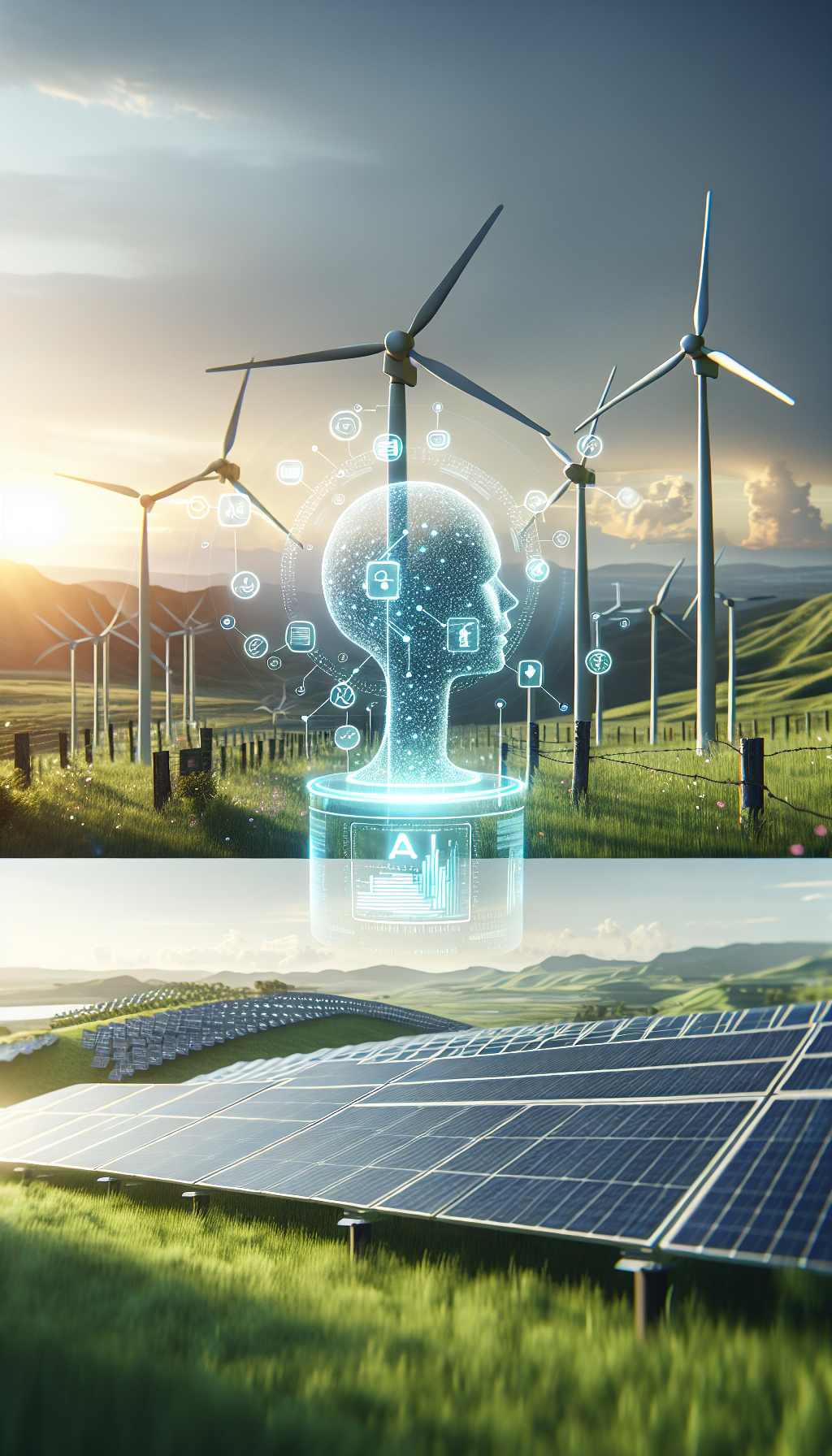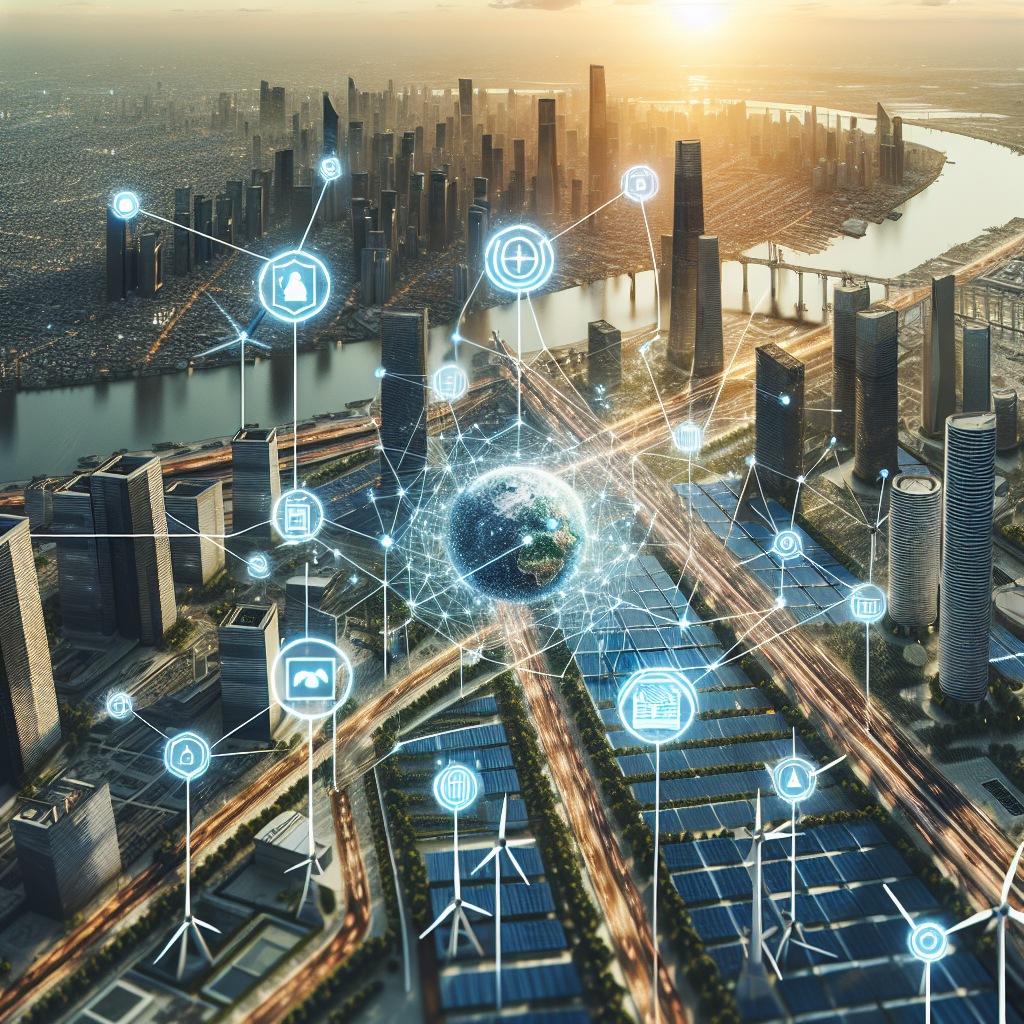AI in Renewable Energy Optimization
Artificial Intelligence (AI) plays a crucial role in optimizing renewable energy systems, driving efficiency and maximizing energy output. One of the key areas where AI is making a significant impact is in the forecasting of energy production. By leveraging machine learning algorithms, AI can analyze vast amounts of weather data to predict solar and wind energy generation with impressive accuracy. This ability to forecast enables energy providers to better plan and balance their energy supply, reducing waste and ensuring a stable power grid.
Moreover, AI enhances the operational efficiency of renewable energy plants through predictive maintenance. By continuously monitoring equipment performance and analyzing data trends, AI systems can predict potential failures before they occur. This proactive approach not only minimizes downtime but also extends the lifespan of critical infrastructure. For instance, wind turbine sensors collect data on vibration, temperature, and other parameters, which AI systems process to identify anomalies and schedule timely maintenance.
Another significant contribution of AI is in the management and optimization of smart grids. AI algorithms can optimize the distribution of electricity from renewable sources, ensuring that energy is distributed efficiently and effectively across the grid. This involves balancing supply and demand in real-time, integrating energy storage solutions, and facilitating demand response strategies to reduce peak load pressure.
The use of AI in renewable energy optimization is illustrated in the following table:
| AI Application | Benefit |
|---|---|
| Energy Forecasting | Improves accuracy of energy supply predictions |
| Predictive Maintenance | Reduces downtime and maintenance costs |
| Smart Grid Management | Enhances grid efficiency and stability |
Predictive Maintenance for Energy Efficiency
Predictive maintenance is a transformative application of AI that significantly enhances energy efficiency across various sectors. By utilizing advanced algorithms and machine learning models, AI systems can analyze vast amounts of data to predict equipment failures before they occur. This proactive approach ensures that machinery operates at optimal efficiency, minimizing energy waste and reducing the carbon footprint of industrial operations.
One of the key benefits of predictive maintenance is its ability to reduce downtime and maintenance costs. Traditionally, maintenance schedules are based on fixed intervals or after a breakdown occurs, which can lead to unnecessary maintenance or unexpected failures. AI-driven predictive maintenance, however, monitors equipment in real-time, identifying wear and tear patterns that suggest when a piece of equipment is likely to fail. This allows for timely interventions, ensuring continuous operation and energy efficiency.
To illustrate the effectiveness of predictive maintenance, consider the following data on its impact:
| Parameter | Traditional Maintenance | Predictive Maintenance |
|---|---|---|
| Unplanned Downtime | 20% | 5% |
| Maintenance Costs | 100% | 50% |
| Energy Efficiency | 80% | 95% |
Furthermore, predictive maintenance contributes to sustainability by extending the lifespan of equipment. By preventing unnecessary wear and tear, AI ensures that machines are not prematurely decommissioned, thereby reducing the demand for new resources and the environmental impact of manufacturing new equipment. In essence, predictive maintenance not only enhances operational efficiency but also aligns with the broader goal of achieving net-zero emissions.
Smart Grids and AI Integration
Smart grids represent a significant evolution in how electricity is supplied and used, driven by the need for improved efficiency, reliability, and sustainability. The integration of Artificial Intelligence (AI) into smart grids is a game-changer, providing enhanced capabilities for managing the complex and dynamic nature of modern power systems. AI technologies enable the automation of decision-making processes and facilitate the real-time analysis of vast amounts of data collected from various grid components.
One of the key benefits of AI in smart grids is the optimization of energy distribution. AI algorithms can analyze data from millions of sensors and devices, optimizing electricity flow to reduce energy waste and prevent overloads. This leads to not only improved operational efficiency but also significant reductions in carbon emissions, contributing to the net-zero goals. Furthermore, AI can predict energy demand more accurately, allowing for better integration of renewable energy sources such as wind and solar power.
AI also plays a crucial role in enhancing the resilience and reliability of smart grids. By using predictive maintenance techniques, AI can identify potential failures in grid infrastructure before they occur. This proactive approach minimizes downtime and extends the lifespan of grid components, ensuring a stable power supply. Additionally, AI can improve the management of distributed energy resources by balancing supply and demand in real-time, which is crucial for accommodating the intermittent nature of renewable energy sources.
To fully realize the potential of AI in smart grids, there are several challenges that need to be addressed, such as data privacy and cybersecurity. However, the benefits of AI integration, including increased efficiency, reduced emissions, and enhanced grid reliability, make it an indispensable tool in the transition towards sustainable energy systems. As AI technologies continue to advance, their role in smart grids will undoubtedly become even more pivotal in achieving a sustainable energy future.
AI-Driven Carbon Capture Technologies
Artificial Intelligence (AI) is revolutionizing carbon capture technologies, providing innovative solutions to reduce greenhouse gas emissions more effectively. Traditional carbon capture methods can be costly and energy-intensive. However, AI offers a pathway to enhance efficiency and reduce operational costs. By using advanced algorithms, AI can optimize the carbon capture process, making it more economically viable and scalable.
One of the significant advancements in AI-driven carbon capture is the ability to predict and optimize the capture process in real-time. AI systems can analyze vast amounts of data from carbon capture facilities to identify patterns and inefficiencies. This enables operators to make data-driven decisions to enhance performance. For instance, AI can help in fine-tuning the chemical composition used in the capture process, ensuring maximum absorption of carbon dioxide with minimal energy expenditure.
Furthermore, AI is playing a crucial role in the development of new materials for carbon capture. Machine learning algorithms can screen thousands of potential materials quickly, identifying those with the best properties for capturing CO2. This accelerates the research and development phase, significantly shortening the time required to bring new technologies to market. Below is a data representation of AI’s impact on different stages of carbon capture:
| Stage | AI Impact | Efficiency Improvement |
|---|---|---|
| Material Selection | Machine learning for rapid screening | Up to 50% |
| Process Optimization | Real-time data analysis | 20-30% |
| Operational Management | Predictive maintenance | 15-25% |
In conclusion, AI-driven carbon capture technologies are crucial in the journey towards net-zero emissions. By enhancing the efficiency and effectiveness of carbon capture processes, AI not only reduces costs but also accelerates the adoption of these technologies on a global scale. As research continues, it is expected that AI will unlock even more potential, making carbon capture an integral part of climate change mitigation strategies.
AI in Sustainable Transportation
Artificial Intelligence (AI) is revolutionizing the transportation sector, making it more sustainable and efficient. One of the primary applications of AI in sustainable transportation is the optimization of traffic flow. By utilizing AI algorithms, traffic signals can be adjusted in real-time to reduce congestion, thereby minimizing idle time for vehicles. This not only improves fuel efficiency but also cuts down on greenhouse gas emissions. Furthermore, AI can enhance route planning for public transportation systems, ensuring that buses and trains operate with maximum efficiency and minimal environmental impact.
Another critical area where AI contributes is in predictive maintenance for transportation infrastructure and vehicles. AI models can analyze data from sensors installed in roads, bridges, and vehicles to predict when maintenance is required. This proactive approach helps in reducing unexpected breakdowns and prolongs the lifespan of infrastructure and vehicles, leading to less waste and more efficient use of resources. For electric vehicles (EVs), AI can optimize battery management systems, extending battery life and enhancing performance, making electric transportation more viable and sustainable.
Self-driving vehicles also benefit from AI’s capabilities, offering the potential to transform urban mobility. Autonomous vehicles can communicate with each other and with traffic management systems to improve traffic flow and reduce accidents. As these vehicles become more mainstream, the reduction in traffic congestion and emissions could be significant. Moreover, shared autonomous vehicle services can lead to a decrease in the number of vehicles needed on the road, contributing further to emission reduction efforts.
Here is a brief overview of AI applications in sustainable transportation:
- Traffic flow optimization
- Predictive maintenance for infrastructure and vehicles
- Route planning for public transit
- Battery management for electric vehicles
- Development of autonomous vehicles
Table: Impact of AI on Transportation Emissions
| AI Application | Emission Reduction Potential |
|---|---|
| Traffic Flow Optimization | Up to 25% reduction in emissions |
| Predictive Maintenance | 15% reduction in resource use |
| Autonomous Vehicles | 30% reduction in traffic congestion |
AI for Waste Management and Recycling
Artificial Intelligence (AI) is revolutionizing waste management and recycling processes by introducing innovative solutions that optimize efficiency and accuracy. As urban populations grow and consumption increases, managing waste effectively becomes a critical component in achieving net-zero emissions. AI technologies provide a data-driven approach to sorting and recycling, significantly reducing the environmental impact of waste.
One of the primary benefits of AI in waste management is its ability to automate the sorting process. Traditional waste sorting methods are labor-intensive and often result in contamination of recyclables, reducing the efficiency of recycling. AI-powered robots and computer vision systems can accurately identify and segregate different types of waste materials. These systems use machine learning algorithms to improve their sorting accuracy over time, ensuring that recyclable materials are properly processed and reused. This not only enhances recycling rates but also minimizes the amount of waste sent to landfills.
AI also plays a crucial role in predictive maintenance and route optimization for waste collection vehicles, which are vital for reducing emissions. By analyzing data collected from various sources, AI can predict equipment failures and schedule timely maintenance, preventing breakdowns and ensuring the smooth operation of waste management systems. Additionally, AI algorithms can optimize waste collection routes, reducing fuel consumption and greenhouse gas emissions. This optimization is achieved by analyzing traffic patterns, waste generation data, and other relevant factors to create the most efficient routes.
Moreover, AI facilitates better decision-making in recycling facilities by providing actionable insights through data analysis. By examining large datasets on waste composition and recycling rates, AI systems can identify trends and inefficiencies, guiding improvements in recycling processes. These insights can help facilities adapt to changes in waste streams and market demands, ensuring that recycling operations remain sustainable and economically viable. In this way, AI not only enhances the efficiency of waste management but also supports the broader goal of achieving net-zero emissions.
Precision Agriculture with AI
Precision agriculture is a cutting-edge farming management concept that utilizes AI technologies to enhance agricultural efficiency and productivity. By integrating AI, farmers can optimize the use of resources, thereby reducing waste and minimizing environmental impact. This approach is crucial in the context of achieving net-zero emissions, as agriculture is a significant source of greenhouse gases.
AI technologies can process vast amounts of data from various sources such as satellite imagery, weather forecasts, and soil sensors. These data points enable farmers to make informed decisions about planting, watering, and harvesting. For instance, AI algorithms can analyze soil health and predict the best times for planting and irrigation, ensuring that water usage is minimized. This not only conserves water but also reduces the energy needed for irrigation systems, contributing to lower carbon emissions.
Moreover, AI-powered drones and robots can carry out tasks like planting seeds, applying fertilizers, and monitoring crop health with precision. This reduces the need for heavy machinery, which often relies on fossil fuels. In addition, AI can help in pest and disease detection, allowing for targeted pesticide application, which reduces chemical use and prevents further environmental degradation.
Incorporating AI into agriculture also supports sustainable land management practices. By analyzing historical data and current conditions, AI can recommend crop rotations and other practices that maintain soil health and sequester carbon. This holistic approach not only boosts yield and efficiency but also plays a vital role in reducing the carbon footprint of agriculture, aligning with the global goal of net-zero emissions.
AI-Powered Climate Modeling
AI-powered climate modeling is revolutionizing the way scientists and policymakers understand and predict climate change. By leveraging machine learning algorithms and vast datasets, AI can simulate complex climate systems with unprecedented accuracy. This enables researchers to generate more reliable forecasts, which are crucial for developing strategies to mitigate the impacts of climate change. AI models can analyze historical climate data, identify patterns, and predict future trends in temperature, precipitation, and extreme weather events with improved precision.
One of the key advantages of AI in climate modeling is its ability to process large volumes of data quickly and efficiently. Traditional climate models often struggle with the sheer scale of data available, but AI can manage and analyze this information at a much faster rate. For instance, a recent study demonstrated that AI algorithms could reduce the time required for climate simulations by up to 90% compared to traditional methods. This significant improvement allows scientists to test more scenarios in less time, leading to more comprehensive understanding and better-informed decision-making.
AI also enhances the granularity of climate models, allowing for more localized predictions. This is particularly important for regions vulnerable to climate change, as it enables tailored adaptation and mitigation strategies. Moreover, AI can integrate various data sources, such as satellite imagery and ground sensors, to provide a holistic view of climate dynamics. By incorporating diverse datasets, AI models can offer insights into how different environmental factors interact and influence climate patterns.
Furthermore, AI-powered climate models are instrumental in evaluating the effectiveness of different carbon reduction strategies. They can simulate the potential outcomes of various interventions, such as reforestation, renewable energy adoption, and changes in agricultural practices. This capability allows policymakers to assess the impact of their initiatives and optimize their efforts toward achieving net-zero emissions. As AI technology continues to advance, its role in climate modeling will undoubtedly become even more integral to our fight against climate change.
AI in Industrial Process Optimization
Artificial Intelligence (AI) has emerged as a crucial tool in optimizing industrial processes, which is a significant step towards achieving net-zero emissions. Industries are responsible for a substantial portion of global carbon emissions, and enhancing their efficiency can lead to considerable reductions. AI technologies facilitate the fine-tuning of manufacturing processes by analyzing vast amounts of data and identifying patterns that are not discernible to the human eye. Through the implementation of AI, industries can optimize resource use, reduce waste, and increase overall efficiency. This, in turn, can lead to a significant decrease in emissions.
One of the primary ways AI contributes to industrial process optimization is through predictive maintenance. By using AI algorithms to predict equipment failures before they occur, industries can avoid unexpected downtimes and inefficient operations. This is achieved by monitoring equipment performance in real-time and identifying early signs of potential issues. By addressing these issues preemptively, industries can maintain optimal operating conditions, thus minimizing energy waste and reducing emissions. The implementation of predictive maintenance has shown to improve reliability and extend the lifespan of machinery, further contributing to sustainability goals.
Another area where AI proves valuable is in energy management within industrial settings. AI systems can analyze energy consumption patterns and suggest adjustments to minimize energy use during peak times. This is often achieved through the integration of smart grid technologies, which allow for more efficient energy distribution and utilization. Below is a simple visualization of how AI aids in energy management:
| AI Application | Impact |
|---|---|
| Predictive Maintenance | Reduces downtime, extends equipment life |
| Energy Management | Optimizes energy use, reduces peak demand |
The synergy of AI with industrial processes not only enhances efficiency but also aligns with broader environmental goals. By reducing the carbon footprint of industrial activities, AI supports industries in their journey towards sustainable and eco-friendly operations. As AI technologies continue to evolve, their role in industrial process optimization is expected to expand, further aiding the global effort to achieve net-zero emissions.
AI and Energy Consumption Monitoring
Artificial Intelligence (AI) is transforming the way we monitor and manage energy consumption, paving the path towards achieving net-zero emissions. By utilizing advanced machine learning algorithms and real-time data analytics, AI systems can provide deep insights into energy usage patterns and inefficiencies. This not only helps in reducing waste but also enhances the overall efficiency of energy consumption across different sectors.
One of the primary advantages of using AI in energy consumption monitoring is its ability to process vast amounts of data quickly and accurately. This enables the identification of trends and anomalies that might be overlooked by human analysis. For instance, AI can detect unusual spikes in energy use, indicating potential equipment malfunctions or energy leaks. By addressing these issues promptly, organizations can significantly cut down their energy wastage.
Moreover, AI-driven monitoring systems can integrate with smart meters and IoT devices to provide a holistic view of energy consumption. This integration facilitates more accurate demand forecasting and load management, crucial for balancing supply and demand in the energy grid. Below is a simplified illustration of how AI assists in energy consumption monitoring:
| Key Feature | AI Application | Impact |
|---|---|---|
| Real-time Monitoring | AI algorithms track energy usage live | Immediate detection of inefficiencies |
| Predictive Analysis | Machine learning forecasts energy needs | Improved energy distribution |
| Automated Insights | AI provides actionable recommendations | Enhanced decision making |
In conclusion, AI’s role in energy consumption monitoring is pivotal for the transition towards sustainable energy practices. By providing detailed insights and fostering proactive energy management, AI not only aids in reducing carbon footprints but also supports the global initiative of reaching net-zero emissions. As technology advances, the integration of AI in energy systems will likely become more sophisticated, offering even greater opportunities for efficiency and sustainability.
AI in Policy Making and Simulation
AI technologies are transforming the landscape of policy making and simulation by providing advanced tools for governments and organizations to model, predict, and implement effective strategies aimed at achieving net-zero emissions. Through the use of machine learning algorithms and big data analytics, AI can process vast amounts of information to identify trends, simulate outcomes, and recommend policy actions that can significantly reduce carbon footprints.
One of the primary ways AI contributes to policy making is through predictive analytics. By analyzing historical data and current trends, AI can forecast future emissions and assess the impact of various policy measures. This enables policymakers to make informed decisions that are both effective and sustainable. Moreover, AI-driven simulations can model complex systems, such as transportation and energy networks, to predict the outcomes of implementing different policies and initiatives.
AI also plays a crucial role in stakeholder engagement and communication. By providing clear, data-driven visualizations and simulations, AI helps bridge the gap between technical experts and policymakers, ensuring that all parties have a shared understanding of the challenges and potential solutions. This collaborative approach is essential for developing policies that are not only technically feasible but also socially and politically acceptable.
| AI Application | Benefits in Policy Making |
|---|---|
| Predictive Analytics | Forecast future emissions and assess policy impacts |
| Simulation Models | Test different scenarios and predict policy outcomes |
| Data Visualization | Enhance understanding and communication among stakeholders |
Finally, the role of AI in policy making extends to international cooperation. With climate change being a global issue, AI-driven simulations can facilitate cross-border collaborations by providing a common platform to analyze data and share insights. This fosters a unified approach in tackling emissions on a global scale, ensuring that efforts are harmonized and resources are effectively utilized.
Challenges and Ethical Considerations
As AI increasingly becomes a critical tool in the quest for net-zero emissions, several challenges and ethical considerations must be addressed. One primary challenge is the energy consumption of AI technologies themselves. While AI can optimize energy usage across various sectors, the computational power required for AI algorithms, especially in training large models, can be substantial. This paradox requires a balance between utilizing AI for energy savings and minimizing its own carbon footprint.
Data Privacy and Security: Another significant concern is data privacy and security. AI systems rely heavily on data, which often includes sensitive or personal information. Ensuring this data is collected, stored, and processed ethically is paramount. There are risks of data breaches or misuse, which could undermine public trust and hinder the deployment of AI solutions in energy systems.
Equity and Accessibility: AI technologies have the potential to widen the gap between developed and developing regions if not implemented thoughtfully. Access to advanced AI tools and the infrastructure to support them is not uniform across the globe. This disparity could lead to unequal benefits, where only certain regions can fully leverage AI to achieve net-zero emissions. It is crucial to develop strategies that ensure equitable access to AI technologies worldwide.
Moreover, the deployment of AI in achieving net-zero emissions raises ethical questions about decision-making and accountability. AI systems can make autonomous decisions based on data analysis, but the lack of human oversight in some scenarios might lead to unintended consequences. Establishing clear lines of accountability and ensuring human oversight in AI-driven processes are necessary to mitigate potential ethical issues.
| Challenge | Impact |
|---|---|
| Energy Consumption | High computational needs of AI could offset energy savings. |
| Data Privacy | Risk of breaches and misuse affecting public trust. |
| Equity | Potential to exacerbate global disparities in technology access. |
| Accountability | Need for clear oversight in AI-driven decisions. |
Future Prospects of AI in Sustainability
The integration of AI in sustainability initiatives is rapidly evolving, opening up new avenues for innovation and efficiency. As AI technologies become more sophisticated, their potential to transform the way we approach environmental challenges continues to grow. One key area of future development is the enhancement of renewable energy systems. AI algorithms can optimize energy storage and distribution, ensuring renewable resources like wind and solar power are utilized to their fullest potential. This optimization not only maximizes efficiency but also reduces waste, making sustainable energy more reliable and cost-effective.
Another promising prospect lies in predictive maintenance and smart grids. By employing machine learning models, systems can predict equipment failures before they occur, allowing for timely maintenance and reducing downtime. This approach not only enhances the operational efficiency of energy systems but also extends the lifespan of infrastructure. Furthermore, AI-driven smart grids can dynamically adjust energy distribution based on real-time demand, significantly improving energy efficiency and reducing emissions.
Sustainable transportation is also set to benefit greatly from AI advancements. Autonomous vehicles, guided by AI, promise to revolutionize the transport sector by reducing emissions through more efficient driving patterns and optimized route planning. Additionally, AI can facilitate the development of urban mobility solutions that prioritize low-emission transport options, contributing to cleaner and more sustainable cities.
In summary, the future of AI in sustainability is bright, with numerous opportunities for growth and innovation. As the technology advances, we can expect to see even more significant contributions from AI in the quest for net-zero emissions. The strategic implementation of AI across various sectors will be crucial in achieving a sustainable future for generations to come.



